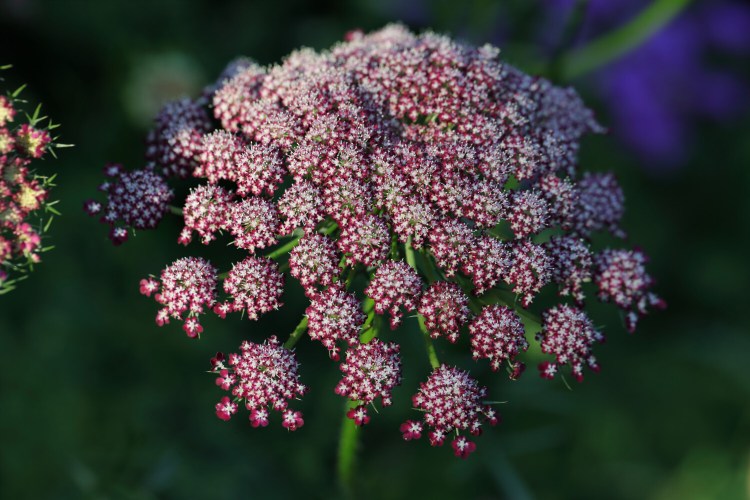Because our property – except for the vegetable garden – is mostly shaded, I was pleased that the Perennial Plant Association’s plant of the year for 2020 is a dramatic, shade-loving plant.
Aralia cordata ‘Sun King’ has excellent foliage, small flowers in mid- to late summer and inedible purple berries at the end of the season. It is hardy to Zone 3, which means it will grow in even the coldest, inland parts of Maine. It grows up to 3 feet tall and 3 feet wide, and has bright gold compound leaves that stand out from their red stems, although the leaves will turn to a lime green late in the season if the plant doesn’t get a couple hours of sunlight each day. Sun King would mix well with hostas and other woodland perennials and is fairly easy to maintain.
A good thing about the Perennial Plant Association’s plant of the year for 2020 is that it is not a new introduction. Sun King has been around awhile and has proven its worth in real people’s real gardens.
It has one problem, however. The common name is Japanese spikenard, meaning – no shock here – that it is not native to Maine. As an increasing number of gardeners switch to native plants, which provide crucial food and habitat for native wild life, they may avoid ‘Sun King.’
Fortunately, those gardeners have a good alternative.
Aralia racemosa, American spikenard or Indian root, is a member of the ginseng family and native to most of the Eastern United States and Canada. It has many of the same attributes as its Japanese cousin – size, large compound leaves, small white flowers and purple berries – but its foliage is green instead of golden.
While humans can’t eat the berries, birds love them. According to the website of the Missouri Botanical Garden, the fleshy roots of American spikenard are medicinal and sometimes used in teas and root beer. Gardeners who want the golden leaves may stick with the import. But I’ve got a wooded area I’m trying to fill and will pick up one of the natives this spring.
All-America Selections
All-America Selections has selected nine national AAS winners this year, along with one regional winner that includes the Northeast.
It could be that I have been writing this column for too long, but none of the selections blew me away. For starters, Johnny’s Selected Seeds, which has had multiple winners in the past, had no winners this year, and I miss the Maine connection. Also – I sort of hate to admit this – as I get older I like to stick with familiar things. Finally, if I described all 10 of them, I’d put you to sleep.
Instead, I’ll describe four of them briefly and let you discover the rest on your own.
I like Pumpkin Blue Prince for the simple reason that I’ve never seen a blue pumpkin before. This is an eating pumpkin, not a jack-o-lantern one. According to AAS, it is slightly flattened and grows to 7 to 9 pounds. It flowers and matures earlier than most other pumpkins and is tasty when baked.
Why would we need a new rudbeckia? I wondered. Well, Rudbeckia ‘American Gold Rush’ blooms from June to September and holds some color until frost, and is compact and disease-resistant. Enough said.
Cucumber ‘Green Light’ grows 40 or more fruit per plant when grown on stakes or trellises, is seedless and doesn’t have to be pollinated, AAS says in selecting the vegetable. That is more production than any cucumber I have ever grown.
Echinacea ‘Sombrero Baja Burgundy’ has deep red to burgundy blossoms, unlike any other coneflower I’ve ever seen. It’s an absolutely gorgeous cut flower and is loved by pollinators.
Carey Award on hiatus
The Cary Award, given by Tower Hill Botanical Garden in Boylston, Massachusetts, has no selection this year. Since 1997, it has recommended plants that grow well in New England gardens, and my wife Nancy and I have planted many Cary Award winners over the years. The last winner listed on the organization’s website is for 2018, the bottlebrush buckeye. I planted that native in our yard last year. I’m told that the woman who coordinated the Cary awards program has retired, but the awards committee hopes to have her replacement secured and the awards up and running as soon as it can. Fingers crossed.
Nancy’s Top Pick
I am going to add Nancy’s Favorite Plant for 2020. My wife, whose attention span is much longer than mine, spends more time perusing catalogs than even I do. Her favorite new flower of the year is from the White Flower Farm catalog: Daucus carota ‘Dara.’
This is Queen Anne’s Lace, but instead of the common white flower, this cultivar has a range of colors from maroon to pink (also some white). The stems grow 3 to 4 feet tall, which make the plant excellent for flower arranging.
Queen Anne’s Lace is related to carrots, and it is one of the weed-like flowers we let grow in our vegetable garden. It does appear on some lists of noxious weeds, but we have no trouble keeping it under control.
Tom Atwell is a freelance writer gardening in Cape Elizabeth. He can be contacted at: tomatwell@me.com.
Copy the Story LinkComments are not available on this story.
Send questions/comments to the editors.


